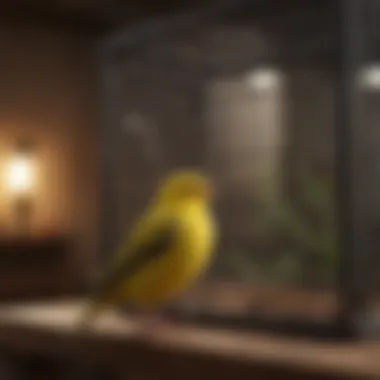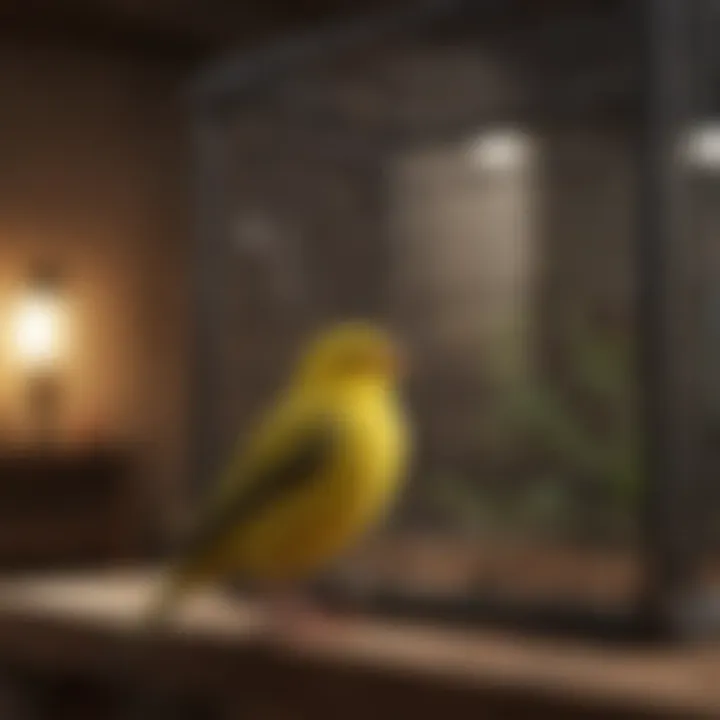Optimal Cage Size for Canaries: A Comprehensive Guide


Intro
Choosing the right cage size for canaries is critical. These small birds require space not only to live but to flourish. A suitable cage can enhance their daily activities and overall happiness. When canaries are provided with the appropriate environment, they exhibit richer behaviors, improved health, and a longer life.
In this guide, we will explore various aspects of canary care. From daily routines to cage maintenance, each element plays a part in creating a thriving atmospheric for these charming pets. Understanding these needs allows canary owners to make informed decisions, benefiting the overall well-being of the birds.
Not only are the dimensions of the cage important, but the setup and the environment within it also are key factors. Each canary has distinct behavioral traits, and addressing these needs will foster a positive experience for the birds and their owners. Throughout this article, we will delve into specifics around cage conditions as well as holistic care that contributes to keeping canaries healthy. Furthermore, the specifics will also guide owners in understanding how to make their small space work for larger needs.
Most importantly, this guide aims to prepare you in every way. Whether you are a first-time bird keeper or looking for advanced management strategies, you will find this comprehensive guide suits your needs at different levels of canary care expertise. You will also uncover effective ways to enhance the social, emotional, and environmental aspects of their living situation which, ultimately, would lead to happier canaries.
So, let's begin our journey by examining essential care tips that can set the foundation for proper habitat and life satisfaction for your canaries.
Care Tips
Proper care starts with a sound understanding of daily routines, cage setup, maintenance, hygiene, and seasonal care adjustments. Together, these elements form a strong base of knowledge that is essential for the proud canary owner.
Daily Care Routines
Creating a routine enables canaries to feel secure and promotes good health. Daily tasks often include fresh food and water, which should be checked every morning. Clean any remnants of spoiled food, as canaries are delicate and a small issue can escalate quickly. Also consider providing time outside the cage for free flight when safe.
Cage Setup and Maintenance
The setup of the cage is essential for avian well-being. Choose a cage that provides height rather than just length or width. Canaries would prefer vertical space to fly and perch. Use horizontal bars spaced close enough to prevent escapes, yet far enough to prevent foot injuries. Maintain the cleanliness of the cage by changing bedding and wiping down surfaces regularly.
Hygiene and Cleaning Practices
Hygiene is a critical component. Ensure thorough cage cleaning at least once a week. Remove all items within the cage, clean surfaces and replace bedding materials. Utilize bird-safe cleaning products, as harmful chemicals can adversely cause harm.
Seasonal Care Adjustments
Rotating care based on seasons is wise. In summer, additional showers mimic natural rainfall, ensuring grooming and hydration. In winter, место покоя (resting areas) can provide warmth. Adjust food and water provisions as birds may require more during certain weather. Seasonal transitions also mean keeping an eye on your birds. Strive to engage regularly and attend to varying behavior dynamics represented over time.
Caring for your canary goes beyond simply providing a cage and some food. When owners are informed and vigilant, they create an enriching habitat full of health and joy.
Intro to Canary Care
Caring for canaries involves understanding their needs beyond just feeding and general maintenance. One of the essential aspects is ensuring they have a suitable living space. This section aims to emphasize the imperative need for proper housing in maintaining the health and happiness of these birds.
Importance of Proper Housing
Canaries are active creatures, often engaging in singing and social interaction. A confinement that is too small can lead to negative behaviors such as inactivity or aggression. Therefore, appropriate housing becomes integral to their well-being.
A larger cage will not only accommodate their needs but also enhance their life quality. Birds, including canaries, thrive with ample room to explore, stretch their wings, and indulge in natural behaviors.
Inadequate housing can cause stress and lead to health issues. With inadequate space, these birds can experience cramped conditions, leading to anxiety and possibly developmental problems. Thus, providing favorable housing conditions functions as a proactive measure against potential health risks.
“A proper house is mandatory for a healthy and harmonious life for canaries.”
Overview of Canary Species
Canaries come in several species, mostly recognizable by their vibrant colors and distinct features. The most common species is the Serinus canaria, ranging from bright yellows to subdued greys. Understanding the different species is crucial, as their environmental needs can slightly vary.
Below are some prominent canary types:
- American Singer: Known for their unique songs and exquisite melodies.
- Border Canaries: Characterized with unique, contrasting colors and a bushy appearance.
- Lizard Canaries: Recognizable for their intricate patterns and curved bodies.
- Gloster: Known for their round shape and charming looks.
Understanding these species assists bird owners in tailoring their cages accordingly. Gaining insights into their character, song, and activity levels is pivotal when selecting appropriate cages. Adequately considering species traits leads to enriched environments where canaries can thrive.
Cage Size Considerations
Choosing the right cage size for canaries is critical to their overall wellbeing and happiness. The dimensions of a cage can significantly influence a canary's mental state and behavior. A well-sized cage allows for natural movements and activities, which are vital for their health. Ensuring proper space helps canaries avoid stress and potential health issues. Careful consideration of cage size can make a noticeable difference in their lifespan and affect their social interactions within a breeding context.
Dimensions for Optimal Living


When it comes to optimum dimensions, several factors combine to determine an ideal cage size. Generally, the minimum total interior space should be around 24 inches in length, 18 inches in depth, and 18 inches in height for a single canary. This size provides enough room for them to stretch their wings, engage in natural behaviors, and interact with their surroundings.
Important elements include but are not limited to:
- Width: Provides more flying space. A longer cage (>30 inches) is preferable for more active individuals.
- Height: Although not as crucial as width, height still matters. Canaries appreciate vertical space, enabling them to hop and flutter upward. Living in a well-structured upward space encourages more natural behaviors.
- Depth: Allows your canary to feel more secure by providing room to explore.
It's essential to note that specific breeds may fare best in distinct dimensions, thus requiring personal research about the canary type. Adhering to these guidelines establishes a comfortable living world for these birds.
Vertical vs Horizontal Space
Before finalizing a cage, one must assess how both vertical and horizontal space can serve a canary's needs. While horizontal space allows for distance fly, vertical space encourages climbing and jumping behaviors. Many canaries enjoy moving vertically through their environment. Consequently, balanced spatial design plays a pivotal role.
In many cases, opt for a tall, narrow cage that allows for climbing. Such designs appear beneficial to captive birds. However, note his:
- Canaries that naturally fly longer won’t benefit as much from tall cages, preferring wide spaces instead.
- Accessories added, such as perches, swinging toys, and ladders, can significantly affect their enjoyment and enrichment.
Overall, birds have unique preferences. Observing individual behavior helps canary owners optimize their living environment, maximizing fulfillment by combining horizontal length while also adding vertical elements.
Factors Influencing Cage Size
Selecting the right cage size for canaries requires careful consideration of various factors. Proper cage dimensions do not only accommodate physical needs; they also support the mental health and behavioral patterns of canaries. Environmental harmony is closely correlated with cage specifications, which makes understanding these influences crucial for any bird owner. This section will explore critical factors such as size, breed variations, and the activity levels of canaries.
Canary Size and Breed Variations
When assessing cage size, canary size and breed variations play a significant role. Different breeds can exhibit considerable differences in physical size and weight. For example, the popular American Singer canary has a medium build, while the Yorkshire canary is known for its size, often larger than most others.
Larger breeds naturally require more space to move freely. The portability of the cage itself may also be impacted; thus, understanding the needs of each canary breed contributes to creating a harmonious living space.
It’s also important to consider the specific needs related to size. Some canaries display colorful plumage and active personalities, showcasing a flair for movement. Allocating adequate cage space ensures that canaries can stretch and perform natural behaviors without feeling confined. As a general rule, larger canary breeds fare better in cages designed with proportionate measurements.
Activity Levels and Behavior
Canaries are active animals. Daily exploration, chirping, and social interactions keep them engaged. When determining cage size, it is vital to understand individual activity levels. Birds with high activity levels need more extensive space compared to those that are relatively calm.
Signs of this high activity include:
- Frequent fluttering or hopping around the perches
- Regular singing and vocalizations
- Interest in climbing and movement a An environment with ample space to roam helps reduce anxiety and promotes behavioral well-being. Conversely, a cramped cage can result in numerous behavioral issues, from boredom to even aggression. Providing sufficient space allows canaries to engage in flight without interference, leading to a healthier bird overall.
A larger cage offers a diverse environment where canaries can express their energetic behaviors, thus improving their quality of life.
In balance, every factor, from breed to natural behavior, contributes uniquely to the longevity and happiness of canaries. An adequately sized cage minimizes stressors and encourages if they will thrive efficiently in their little habitat. Prioritizing these considerations will lead to better care and overall well-being for your beloved pet.
Minimum Cage Size Recommendations
Understanding the minimum cage size for canaries is crucial for their health and happiness. The dimensions of a cage can significantly affect a canary’s daily life and overall well-being. Selecting an adequate cage size allows your canary space to move, fly, and engage in typical behaviors, which is essential for both their physical and mental health. This section highlights what to consider when choosing the right size.
Single Canaries
For a single canary, a cage with a minimum width of 24 inches is recommended. The height should be at least 18 inches. This offers enough room for the canary to fly short distances and explore without limitations. Depth is also important, but focal point should be the width since canaries are more inclined to fly horizontally.
When setting up a cage for a solo canary, ensure the space is not too overwhelming. It’s common that a larger cage can provide a sense of comfort, preventing stress which makes canaries more relaxed.
Benefits of appropriate cage size for single canaries include:
- Enhanced ability to exercise, reducing obesity and other related health issues.
- More opportunities for natural behaviors, such as flapping and social interaction, if they can view their surroundings clearly.
Pairing Canaries
When keeping a pair of canaries, the recommended minimum measurement increases. Ideally, the cage should measure at least 30 inches in width, with varying heights recommended around 24 inches. This not only promotes territory for each bird but also fosters harmonious interactions.
The less space a pair has, the more potential there can be for conflict over territory and resources. Adequate cage size provides areas for the canaries to retreat to when desired. This reduces unnecessary stress and aggression during paired living.
Key considerations for paired canaries are:
- Balanced space to discourage fighting and encourage bonding.
- Additional perches and toys placed strategically can help without crowding.


Adequate space is not purely a luxury; it’s a necessity for thriving canaries. Don't treat size as an afterthought, but rather an investment in their quality of life.
Assessing Cage Shape and Design
Assessing the shape and design of your canary's cage is vital for creating a secure and functional environment. The shape influences movement and how effectively a bird can utilize its space. First, consider whether the cage is rectangular or more unusual shapes like round or cornered designs. Rectangular cages are often the most practical choice because they provide maximum flying distance, which is essential for your canary's exercise and overall well-being.
You also need to consider the overall dimensions. For instance, a tall cage may benefit height-loving breeds, but if it lacks sufficient width, the bird might not be able to fly comfortably. A standard rectangular cage, therefore, should possess both ample height and width for horizontal movement.
In addition to space, you need to think about how additional features affect accessibility. Design elements, like the entrance point, should allow for easy and safe access for cleaning and feeding. This ultimately minimizes stress during handling, which is as important as spatial dimensions.
The shape of your canary's cage can significantly impact its quality of life.
Bar Spacing and Material
Bar spacing and material represent foundational components of cage design that ensure safety and comfort. Generally, bar spacing should be no more than half an inch apart. This prevents canaries from squeezing through, which could lead to injury or escape. Material choice further impacts safety; stainless steel cages are durable, easy to clean, and less prone to rust, while painted cages might require more care to avoid chipping and toxicity concerns. Using non-toxic materials can enhance your canary’s safety.
Investing time in choosing the right bars and materials creates a backyard suitable for exercise and rest. As canaries are active by nature, sturdy bars that can withstand their movements are essential, ensuring the cage serves its intended purpose effectively.
Placement of Accessories
The placement of accessories within the cage serves to maximize enjoyment and engagement for your canary. Accessories include perches, food dishes, and toys. Each should be arranged in a manner that promotes movement yet respects your canary's natural behavior.
- Perches should be positioned at different heights. This not only encourages climbing but also mimics a more natural environment.
- Food and water dishes should be easily accessible but placed low enough to avoid contamination.
- Toys should be spaced throughout to prevent any territorial behavior and must be varied to stimulate different activities.
To maintain a rich environment, consider changing the arrangement of accessories regularly. This habit is effective in achieving continuous interaction and fun sprawls that horticulturalists might index as enriching.
Overall, strategic placement contributes significantly to both the functionality and aesthetic of your canary's habitat.
Importance of Enrichment in Cage Setup
Enrichment is essential for the well-being of canaries. Proper enrichment in their cage setup goes beyond mere space. It often determines their happiness, mental health, and overall behavior. Canaries require stimulation to thrive not just quickly, but consistently. Without adequate enrichment, these birds can develop behavioral issues. They might start exhibiting signs of stress or boredom, such as excessive feather plucking or incessant chirping.
Toys and Perches
Toys and perches are two key elements of enrichment that should be thoughtfully considered. Toys can range from simple wooden blocks to complex foraging toys. Each type offers different forms of stimulation. For example, foraging toys encourage natural behaviors. They require the birds to work for their food, mimicking how they would behave in the wild.
Do not forget the importance of perches either. Different shapes and sizes invite exploration. Natural wood perches are favorable because they are gentle on a canary's feet. Also, purchasing perches of varying diameters can enhance muscle tone and strength in their feet. The cumulative effect of various toys and perches will encourage a more engaging environment.
- Benefits of integrating toys and perches:
- Encourage exploration and physical activity.
- Reduce boredom and stress.
- Stimulate natural instincts.
Therefore, when selecting toys, consider which ones will safely offer the best benefits for your canary. Rotate toys periodically to sustain their interest. This way, you create a dynamic habitat.
Social Interaction Considerations
Social interaction is another critical component of enrichment in canary care. Canaries are social creatures, particularly species such as the American Singer and the European Serin. Interaction with humans and other birds is vital for their emotional health. It’s necessary to strike a balance between engagement and providing safe spaces for your canaries to retreat.
Consider spending quality time with your canary daily. This could include simply sitting nearby while talking softly or teaching them tricks. If you are thinking about housing them in pairs, monitor interactions to ensure compatibility. This can prevent easy problems such as aggression between birds whenever they do not gel well together.
Regular interaction helps build trust and minimize anxiety. You don't want your canary to live isolated or under too much stress.
The goal should be to give your canaries not just a structure to live in, but a space that enriches their lives. Both toys, perches, and social interaction can contribute heavily to creating that ideal environment for lasting happiness. They not only maintain physical well-being through enrichment but also feed into their psychological needs. Make the space expressive and interactive to help your canaries flourish.
Common Mistakes in Cage Sizing
Understanding cage sizing for canaries is essential. Many unforseen faktors can lead to choosing unsuitable habitats. Mistakes in selecting a cage can impact the overall happiness and health oft these birds. Recognizing these common errors can help pet owners provide a betteer living situation for their feathered companions.
Underestimating Space Needs
Many new canary owners fail to grasp how much room their birds actually require. This is a frequent problem that can stem from misinformed assumptions about the amount of space needed for even a single bird. Some may believe that a small cage will suffice for an active canary.
However, an adequate cage should allow for both horizontal and vertical movement. Canaries are naturally energetic creatures, engaging in crueltyllis activity such as climbing and flapping. A spacious cage allows them to express these behaviors, which are crucial for maintaining their well-being.
Key points to consider include:


- Cage dimensions: Ensure the cage dimensions are significantly larger than the minimum recommendations.
- Proper activity: Birds require space to move around freely, stretch their wings, and practice their social behaviors.
Overlooking these dimensions could lead to stress, restlessness, and even health problems for your canary. An empty cage may not suffice.
Neglecting Vertical Space
While many may focus solely on the horizontal dimensions, neglecting vertical space is a common error in cage setting. Canaries often perch higher when they feel safe and secure. They thrive in environments where they can soar vertically to explore and feel less vulnerable. This is particularly important for species like the American Singer, whose nature demands exploration and climbing.
Investing in a tall and spacious cage can offer vital vertical exposure:
- Perches at various heights give the canaries clustering spots to show off their social behaviors.
- Toys suspended high in the cage encourage flying and climbing, promoting physical well-being.
Summary of common traps:
- Caging without dimensions: Failing to evaluate large coverage areas leads to cramped spaces that fail to meet exercise needs
- Ignoring social structuring: Social integration impacts mental states for canaries.
Ensuring optimal handling aftter making upgrades involves continuous sewing for ample space above ground.
In summary, strongly consider both measurements and quality of space provided to your canary. Overcoming these mistakes will lead to a healthier habitat, ultimately benefiting the pets and caregivers alike.
Signs of Inadequate Housing
Understanding the signs of inadequate housing for canaries is critical. Proper eye for the animal's needs can lead to years of healthy companionship. Canaries thrive in environments that mimic their natural habitats. When these conditions are not met, the risks to their behavioral well-being and physical health increase significantly.
Behavioral Indicators
Canaries are social creatures. They display behaviors that hint at their mood. One major indicator is excessive vocalization. A canary that is normally chirpy but suddenly becomes quiet may be feeling constrained. It might be a sign it's unhappy with its housing. Canaries can also exhibit feather plucking or aggression towards others. These behaviors indicate stress and can lead to serious problems if left unaddressed.
Other signs to look for include erratic movement patterns. If a canary spends a lot of time staying at one spot or is uncharacteristically lethargic, this can mean something is not right with its housing arrangement. A limited space doesn't allow for healthy movement and play which is essential for their overall happiness.
To better understand these behaviors, observe changes in daily routines and interactions. Keeping a journal documenting these behaviors can provide valuable insight into when changes occur.
Health Concerns Linked to Space
The size of a cage doesn't only affect behavior; it also contributes directly to the bird's health. Canaries trapped in small environments may suffer from different perilous conditions. For example, they might experience obesity due to insufficient exercise options. Without space to stretch and fly, vital muscles weaken over time.
Moreover, cramped spaces can lead to psychological issues. Stress can weaken their immune system. When the bird experiences constant anxiety, it becomes more vulnerable to diseases and health complications. Researchers have found a direct line between adequate living conditions and lowered risk for health issues.
To summarize, recognizing inadequate housing signals helps to prevent psychological and physical problems among canaries. By monitoring behavior and understanding health implications linked to small spaces, owners can ensure their pets are as happy and healthy as possible.
Upgrading Cage Size
Upgrading the cage size for your canaries can be a pivotal change for their overall health and happiness. As these birds grow and their behavior evolves, providing adequate space becomes increasingly significant. This section aims to elucidate the factors that necessitate an upgrade, and the corresponding considerations before making such a transition.
When to Consider an Upgrade
Recognizing the signs that suggest a need for a larger cage is crucial for any caregiver of canaries. Some indicators of inadequate space include:
- Restlessness: If your canary appears frequently agitated or restless, it may signify that they feel cramped in their current environment.
- Reduced Activity: A more sedentary bird that spends all its time perched or sitting may indicate that they are not able to move freely enough to engage in natural behaviors.
- Lack of Flight: Canaries are naturally inclined to fly. If yours rarely takes to the air, it might be due to insufficient cage dimensions.
These indicators imply a restricted living situation that necessitates reevaluating the available space.
Transitioning to a New Cage
When the decision has been made to upgrade, the transition process requires careful planning. Here are several steps and tips to consider:
- Select the Right Size: Aim for a spacious cage that allows adequate room for stretching, fluttering, and possibly even vertical climbing. Ensure it aligns with the minimum cage size recommendations for canaries.
- Familiarize Your Canary: Before moving your pet, introduce them to the new cage while it is still in the existing setup. This will help reduce the shock of sudden change once the move occurs.
- Maintain Familiar Elements: Place items like their favorite perches, toys, and food dishes from the old cage into the new cage. Keeping familiar objects can help ease the adjustment process.
- Monitor Behavior: Post-setup, observe your canary’s behavior. Initial signs of nervousness may appear, but with time and acclimatization, they should begin to explore their new environment.
Upgrading the cage size is a beneficial move for both you and your canaries. It not only meets their physical needs but also enhances their overall well-being and quality of life. As these intelligent creatures thrive on enrichment and space, a thoughtfully upgraded cage can create a more stimulating and happy home for them.
End
Understanding the necessity of optimal cage size is crucial in caring for canaries. This article highlighted central ideas regarding cage dimensions and the importance of a suitable environment. Choosing the right size is not just about fulfilling minimal standards; proper housing translates to overall well-being for the bird. Ensuring a comfortable tailored space fosters strong physical health, behavioral happiness, and enhances longevity.
Recap of Key Points
- Cage Size: Sufficient dimensions promote freedom of movement, which impacts their mental and physical states.
- Vertical Space: Canaries naturally prefer to flit upward, making height of the cage important.
- Stimulation: Interaction with toys and perches impacts their engagement and prevents boredom.
- Behavioral Indicators: Signs of stress should prompt evaluations of housing.
- Upgrading Needs: Monitoring canaries as they grow should encourage regular assessments of their current cage.
Final Thoughts on Canary Welfare
Canaries are not merely pets but companions who thrive inclusive environments. Adopting a mindset focused on their welfare can motivate owners to research, adapt, and enhance living conditions. A spacious cage with enriching elements ensures happiness, productivity, and helps them express natural behaviors. Fostering an environment conducive to their needs fosters richer experiences for both the bird and its owner.















